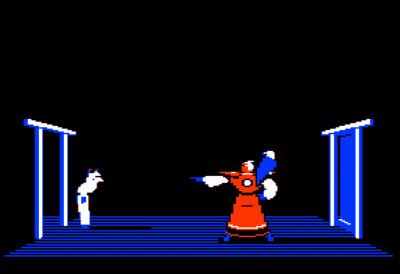How to Ruin Your Investment Portfolio (Part II: Technical Analysis)
- By : Menard
- Category : Investing
- Tags: Day Trading, How-Not-To, Technical Analysis

In Part I of this blog series, I wrote about how day trading your way to riches is a fool’s game. Let’s expound on that a bit by discussing the demerits of employing Technical Analysis.
Humans are by nature impatient. At the supermarket counter, for example, we’d constantly look into our watches when several people are queued ahead of us. If we’re in a hurry, we’d drive to another store even if it takes much longer to get there. And if we actually do, we’d honk at a car in front of us, at some stoplight along the way if the driver hesitates to proceed for safety.
Same is true when it comes to investing. Many people foolishly act like the hare who lost the race against the tortoise. Never mind that slow and steady investing, like regularly contributing to a low-cost mutual fund, has been proven, time and time again, as the surest and most effective way to build wealth for most people.
Never mind that “Technical Analysis is Bullshit” has over a thousand hits on Google. Hare-like investors are more likely to contribute to their Coinbase account than fund their 401Ks or RRSP accounts. They’d rather get stuck with “analysis paralysis” performing Technical Analysis when all they should be doing is setting
This series serves as a “How-NOT-to” guide to investing. We’ll cover practices that you’ll never EVER need to employ to build wealth. Don’t let your debt-hugging neighbor, friend, or relative convince you otherwise.
What the heck is Technical Analysis?
Maybe one day you decided you no longer want to be just an average investor, with average returns, who is “just keeping up with the market” as your golfing buddies tell you. So you decided to finally pay attention to CNBC financial commentators you normally ignore. The problem is that certain English phrases like “We’re approaching resistance” or “We’ve been testing support” suddenly sounded foreign to you.
Welcome to the world of Technical Analysis. In the trading world, you are either a technical or fundamental analyst (techie or fundie). The fundies are well-respected as they analyze numbers that really matter like developments in the economy, interest rates, federal spending, company balance sheet, etc. to determine where the price of a security is headed.
Many well-respected names in finance are fundies… Warren Buffett, Charles Munger, Carl Icahn, George Soros, Ray Dalio, and David Tepper, to name a few. They all have different approaches, but all made their billions by focusing on the fundamentals.
The techie’s focus, on the other hand, is on the price charts hoping to find a pattern (e.g., cup and handle, head and shoulders, double bottom) that is likely to repeat. They do this by studying historical data and focusing primarily on the price and to a lesser degree on volume. This is almost akin to an astrologer’s fascination with the formation of the stars hoping to be able to foretell the future.

The goal of a chart technician is to be one step ahead of the “herd”– the retail investors or traders who are behind the curve. The problem is that this seldom happens as even the most seasoned technicians are more often than not late to the party when a breakout actually occurs.
Fact is, not a single billionaire in the Fortune 400 list is a pure technical analyst. If someone were, I bet my pants that he got his fortune somewhere else and not from studying the charts.
What’s worse is that many are associated with get-rich-quick scams you often find in late-night infomercials. And as a result, they command as much respect as a snake oil salesman. But in fairness, some are not really con men– they’re either just incredibly lucky or simply delusional.
How it all started (Why many believe this nonsense)
Although a few concepts in technical analysis started almost 400 years ago in the Netherlands when tulips were the craze, it was only in the early 18th century that charting was used to record price movements. This was when a certain rice trader named Homma Munehisa invented the candlestick charting technique. It was the first recorded use of charting to “predict” where the price of a commodity like rice is headed.

Back then samurai warriors were paid in rice, so their paychecks fluctuate based on the price of the commodity. So it became extremely important, financially, for the daimyō, the feudal ruler who employ many samurai warriors, to know where the price is headed so he can enter into a futures contract to effectively lock the price.
From there, it evolved as a war strategy such that, in more sinister scenarios, the daimyo would capitalize on very low prices by buying and hoarding rice in an attempt to artificially increase the price of the commodity and starve out the rival clans!

Homma Munehisa had so much success that legend has it that he performed 100 consecutive winning trades. But what many technicians do not understand is that what can work then would not necessarily work in today’s environment. The chances of you being able to duplicate his feat are close to nil.
First, he had the advantage of having invented the technique– he was the first to identify clear patterns in the rice markets.
Second, he had the advantage of speed. He established a network of couriers to make sure he got the latest information ahead of the competition. In a zero-sum game like trading, being a step ahead of another trader is a clear advantage.
Lastly, there were no AI-programmed supercomputers, let alone the internet in ancient Japan!
Think about it. With the number of wonderful trading platforms available today that are capable of recognizing the same patterns (only much much faster), everyone who uses them would be multi-millionaires by now if TA worked half the time.
Here’s a technically analyzed strategy that works
Let me tell you a little secret. If you’re investing, slow and steadily, for the long-term, you don’t need good timing for big gains.
That’s because the long-term direction of the stock market is very predictable— as the global population explodes, and companies here and abroad continue to innovate— the price always goes up!
Instead of being paralyzed doing technical analysis, if you took a simple, consistent approach and INVEST IMMEDIATELY as soon as the money is available and STAYED THE COURSE, you’ll likely be ahead compared to the others.
Fact is, in the 20 year period starting from 1993, if you invested that extra $2,000 you earned, every year, from a side-hustle in the S&P 500 index at the earliest possible moment, you’d end up in second place with $81,650 —only $5,354 less than someone who bought stocks with perfect timing!
And since it’s virtually impossible to perfectly time the market, investing immediately is actually the best strategy for mere mortals like you and me. Dollar Cost Averaging, i.e., contributing a fixed amount on a monthly basis, is a close second.
But what’s really interesting is that having bad timing still has very good results compared to when you stayed in cash. It’s almost always better to invest in stocks— even at the worst time each year— than not to invest at all.
Charles Schwab backtested the scenario across multiple 20-year periods and only 10 of 68 periods had unexpected rankings!
It only goes to show that timing the market doesn’t work—- time in the market is what matters. Being slow and steady, like the tortoise, wins the race!
In Part III, we’ll cover Short Selling.





No Comments